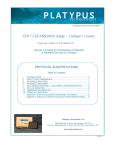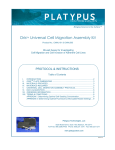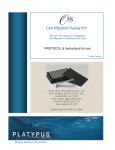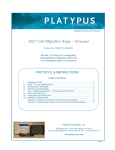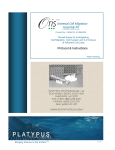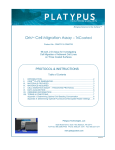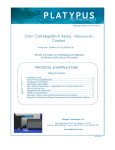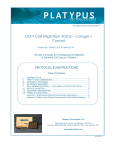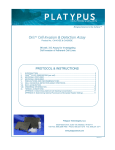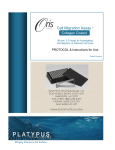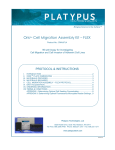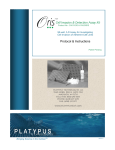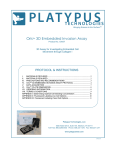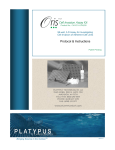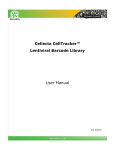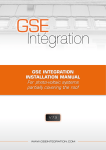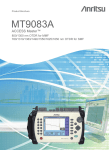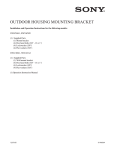Download OrisTM Cell Migration Assay
Transcript
OrisTM Cell Migration Assay Product No.: CMA1.101 & CMA5.101 96-well, 2-D Assay for Investigating Cell Migration of Adherent Cell Lines PROTOCOL & INSTRUCTIONS Table of Contents I. II. III. IV. V. VI. VII. VIII. INTRODUCTION ............................................................................................ 2 TM ORIS PLATE DIMENSIONS ...................................................................... 2 MATERIALS PROVIDED ............................................................................... 3 MATERIALS REQUIRED ............................................................................... 3 CELL MIGRATION ASSAY PROTOCOL....................................................... 4 DATA ACQUISITION ..................................................................................... 6 ORDERING INFORMATION .......................................................................... 8 TERMS & CONDITIONS ................................................................................ 8 APPENDIX I - Determining Optimal Cell Seeding Concentration .................. 9 APPENDIX II - Determining Optimal Fluorescence Plate Reader Settings ... 9 Oris™ CELL MIGRATION ASSAY The Oris™ Cell Migration Assay is a reproducible, sensitive, and flexible assay that can be used to monitor cell migration. Formatted for a 96-well plate, the assay utilizes Oris™ Cell Seeding Stoppers made from a medical-grade silicone to restrict cell seeding to the outer annular regions of the wells. Removal of the stoppers reveals a 2mm diameter unseeded region in the center of each well, i.e., the detection zone, into which the seeded cells may then migrate. The Oris™ Detection Mask is applied to the plate bottom and restricts visualization to the detection zones, allowing only cells that have migrated to be detected (see Figure 1). The Oris™ Cell Migration Assay is designed to be used with any commercially available stain or labeling technique. Readout can be performed by microscopy or use of a microplate reader. The Oris™ Cell Migration Assay system has been designed for use with adherent cell cultures. This assay has been successfully used with HT-1080, PC-3, A549, NCI H1650, MDA-MB-231, NMuMG, 3T3-Swiss albino, HCEC, HUVEC, and MCF10A cell lines. Using the Oris™ Cell Migration Assay offers the following features & benefits: – perform studies without - analyze data using multiple probes in a x x manipulating transmembrane inserts. single well by using a microscope, digital imager, or fluorescence microplate reader. – obtain well-to-well CV's x x - perform kinetic or endpoint cell migration < 12% due to the unique design. assays without the use of special instrumentation. x – monitor changes in cell structure in real-time. ! , " - # # + $ % . & / 0 ( ' # " 1 ( , 2 ) # / 1 $ * * ( + % 8 # # 2 # 4 2 5 1 1 + # - 6 + 1 + ) ; < L M = N > O P ? Q @ R 1 Remove Stoppers to Create Detection Zone A B A ; : ( " 1 Analyze Cells in Detection Zone: Microplate Reader Analysis - Detection Mask Attached; Image Analysis - No Mask Required ; 6.5 mm Diameter of Stopper Space (Detection Zone) 2 mm Suggested Media Volume per Well (populated with Stoppers) 100 µl Effective Area of Outer Annular Region (seeding region) per Well 30.03 mm2 Effective Area of Central Detection Zone per Well 3.14 mm2 Plate Height 14.9 mm TM Cell Seeding Stoppers) Offset of Wells (A-1 location, X) 11.2 mm Distance between Wells 9 mm (on center) Well Depth 12.2 mm Thickness of Well Bottom 0.25 mm Storage Conditions F G H I J H 23.9 mm 14.4 mm Offset of Wells (A-1 location, Y) E 1 Schematic of Oris™ Cell Migration Assay Plate Height with Lid (with Oris D ( Allow Cells to Migrate into Detection Zone Diameter of Well C * 7 Seed & Adhere Cells onto Oris™ Plate K $ 2 9 3 2 Refrigerate (4°C) : Read Instructions Before Performing any OrisTM Assay. www.amsbio.com [email protected] B @ 3 # + A . / 0 * @ ? T + U ; V > 5 W X U X S Y A X 3 Oris™ 96-well, Tissue Culture Treated (black, clear bottom) Plate with Oris™ Cell Seeding Stoppers, 1 Oris™ Detection Mask, 1 Oris™ Stopper Tool, 1 S B @ x x x x x x x x x A @ ? ; A [ A # + . / 0 * T + U V 5 W Z U X Y Biological Cells ++ Sterile PBS (containing both Ca ++ and Mg ) Complete Cell Culture Growth Medium (containing serum) Sterile Pipette Tips/Pipette or Multi-Channel Pipette Trypsin or Cell Scraper Inverted Microscope (optional) Fluorescence Microplate Reader (optional) Cell Culture Labeling Medium (phenol red-free/serum-free media) Cell Labeling Fluorescent Agent (eg., CellTracker™ Green, Calcein AM) \ ] ^ _ ` \ ] a ` b c ] \ b d \ e ` f g h i i h j \ ] h a d _ k l ` h e ` m \ d c n h k X Oris™ 96-well, Tissue Culture Treated (black, clear bottom) Plates with Oris™ Cell Seeding Stoppers, 5 Oris™ Detection Mask, 1 Oris™ Stopper Tool, 1 ] www.amsbio.com \ ] h a ] \ o [email protected] S A ? ? B @ @ ; ; @ > ? The following steps should be performed in a biological hood using aseptic technique to prevent contamination. 1. Remove the Oris™ Cell Migration Assay Plate from refrigeration and place on lab bench for ~1 hour to allow it to equilibrate to room temperature. 2. Visually inspect the underside of the populated 96-well plate to ensure that the Oris™ Cell Seeding Stoppers are firmly sealed against the bottom of the plate. To inspect the stoppers, turn the plate over and examine the stoppers for sealing (see Figure 2). If incomplete sealing is observed, return the plate to the upright position and use a sterile instrument to gently push the stopper back into the well until sealing is observed. the sealing of the stoppers can be most easily observed if the plate is tipped at an angle and viewed under indirect light to reveal the “bullseye” pattern at the bottom of each well. T 3. V K L M N O P R Stoppers that are A) Partially Sealed B) Unsealed C) Completely Sealed Apply the Oris™ Detection Mask to the bottom of the 96-well plate if microplate reader data is being collected. The Detection Mask is not necessary if collecting imaging data. : In order to prevent splashing of well contents, familiarize yourself with the attachment and removal of the Detection Mask before any liquids are placed in the wells. 9 ( # 2 * ( ! 2 # 2 x | s q u } q s p q r s t u v u r w t x y z { w q t s q x Orient the chamfered corners of the mask with those of the 96-well plate, ensuring that the A1 corner of the mask is aligned with the A1 well of the plate (see Figure 3). x Align the holes in the attachment lugs with the bosses on the bottom of the 96well plate. x Gently press the mask until it is flush with the bottom of the 96-well plate. It may be necessary to wash the mask with ethanol to remove dust and debris since the mask is sterile. The mask may be applied at any point during the assay. For kinetic assays, it is often most convenient to apply the mask at the beginning of the assay before any liquids are placed in the well. For endpoint assays, using fixed and stained cells, it is often most convenient to apply the mask just before reading assay results. T V % + 4. If performing a kinetic analysis of cell migration, pre-label with a fluorescent stain now. 5. Collect cells and prepare a suspension that is 10-fold greater in density than the optimal seeding concentration. : The optimum seeding density of cells must be determined as an integral part of the design of the cell migration assay. Please refer to Appendix I for a discussion of this process. 9 6. ( # 2 * ( ! 2 # { ~ M N v s q x u u v ~ s t u } * K L O P R Features of Detection Mask 2 Pipette 100 µl of suspended cells into each test well through one of the side ports of the Oris™ Cell Seeding Stopper. K L M N O P R Media is Added with Single or Multi-Channel Pipette For best results, add or extract media by placing the pipette tip along the wall of the well (see Figure 4). Care should be taken not to disturb the Oris™ Cell Seeding Stopper when introducing the pipette tip into the well. A slender/elongated tip or a gel loading tip may be useful. T V 7. Lightly tap the plate on your work surface to evenly distribute well contents (extreme tapping may result in splashing of well contents and lead to contamination). 8. Incubate the seeded plate containing the Oris™ Cell Seeding Stoppers in a humidified chamber (37°C, 5% CO2) for 4 to 18 hours (cell line dependent) to permit cell attachment. 9. Remove plate from incubator. 3 , W T V www.amsbio.com [email protected] S A ? ? B @ @ ; ; @ > ? 10. Designate several ‘reference’ wells in which the stoppers will remain in place until results are read (t=0 pre-migration controls). 11. Using the Oris™ Stopper Tool, remove all other stoppers (see Figure 5). T V It may be necessary to wash the Oris™ Stopper Tool with 70% ethanol as the Stopper Tool is not sterile. x Secure the 96-well plate by holding it firmly against the deck of your work space. Slide the tines of the Oris™ Stopper Tool under the backbone of the stopper strip, keeping the underside of the Oris™ Stopper Tool flush with the top surface of the plate. x Lift the Oris™ Stopper Tool to gently remove the stoppers. ¡ ¢ ¢ W § ¨ V ¤ T 5 § £ use the Oris™ Stopper Tool as a lever to pry the stoppers from the well (see Figure 5E), as doing so may cause displacement of seeded cells and may distort the detection zone area. T § ¤ § § 12. Remove media with a pipette and wash wells with 100 µl of sterile PBS (or media) to remove any unattached cells. Do not aspirate using an in-house vacuum. ¥ ¦ ¢ £ 13. Add 100 µl of fresh culture media to each well. K 14. Incubate plate in a humidified chamber (37°C, 5% CO2) to permit cell migration. Cells may be examined microscopically throughout the incubation period to monitor progression of migration. Migration time will vary depending upon cell type and experimental design. L M N O P © R Removal of Stoppers. Panels A, B, and C) Position the Tines of the Stopper Tool between the Stopper Tips, D) Lift Vertically, and E) Do NOT Pry Stoppers 15. If performing an endpoint analysis of cell migration, stain cells with a fluorescent stain after sufficient migration has occured. Refer to Section VI and Appendix II for further information on data acquisition and fluorescence staining technique. Oris™ Cell Seeding Stoppers are for single use only; We cannot guarantee the integrity of the s topper material after a second sterilization procedure. T V www.amsbio.com [email protected] @ @ @ [ ; The readout of the Oris™ Cell Migration Assay can be conducted at any time, allowing the user to perform a kinetic assay or an endpoint assay. The Oris™ Cell Migration Assay is designed to be used with any commercially available stain or labeling technique. The readout can be performed by using a microscope, a microplate reader, or a High Content Screening or High Content Imaging Analysis platform. Microscope Analysis x Cell counting or image capture / analysis software, such as NIH ImageJ freeware, can be used. x Note: Microscopy observations are possible using phase contrast or bright field microscopy. x No need to attach the Oris™ Detection Mask to the Oris™ plate. x Sample data using a colorimetric stain is shown in Figure 6. Wells populated with Oris™ Cell Seeding Stoppers were 5 seeded with 50,000 HT-1080 cells (i.e., 100 µl of 5x10 cells/mL) and incubated overnight. The stoppers were removed from test wells, but remained in place in the pre-migration reference wells until the time of the assay readout. The seeded plate was incubated in a humidified chamber for 24 hours to permit cell migration. Stoppers were removed from the reference wells and all cells were fixed and treated with Wright-Giemsa stain. Images were captured using bright field microscopy and then imported to Image J software for analysis using thresholding. The images below, captured without a detection mask in place, illustrate representative data from pre-migration (t=0 hrs) and post-migration (t=24 hrs) wells (Figure 6A). The graph depicts the average pixel number in the detection zones for each condition (Figure 6B). 6A 6B « ¬ ® ¯ ® ° ± ² ² ³ Ù Ú ´ Û µ ¶ · Ü ¸ Ý L ´ ¹ º Ú » Þ ± ß ¸ P ± Þ ¼ P ¸ à ± Þ L ½ ¾ Ý ¿ Ú À Ý ¶ á ´ µ P æ æ L M Æ O ç Ç Þ L ³ Ý ´ Ú ¼ ¶ L ¹ Ú Å Þ ¼ Ý ¹ È = L ¿ M O Á â ç ¸ Q < Þ L Â ä Ã ´ å ± Ä Å ä ã Ý Ú è Ý Ú P = 250000 Ø × Pixel # S 200000 Õ Ö Ò Ï 150000 Õ Ô Ò Ó 100000 Ò Ñ Ð Pre-Migration (t=0 hrs) Post-Migration (t = 24 hrs) Ï 50000 0 No Migration Migration Pre-Migration Post-Migration É Ê Ë Ì Î Í Í Ê Ë N=8/Condition K L M N O P ª R Cell migration data obtained using Wright-Giemsa colorimetric stain. www.amsbio.com [email protected] · Microplate Reader Analysis x Attach the Oris™ Detection Mask to the bottom of the Oris™ plate (refer to Section V, step 3). x Optimal settings will vary according to the microplate reader make and model. Consult Appendix II and the equipment user manual for your particular instrument. x The microplate reader MUST be set to read from the bottom of the plate. x Sample data using a fluorescent stain and microplate reader analysis are shown in Figure 7. Wells populated with Oris™ 5 Cell Seeding Stoppers were seeded with 50,000 HT-1080 cells (i.e., 100 µl of 5x10 cells/mL) and incubated overnight. The stoppers were removed from test wells, but remained in place in the pre-migration reference wells until the time of the assay readout. Cells were fluorescently stained with CellTracker™ Green. The seeded plate was incubated in a humidified chamber for 28 hours and at various time points the fluorescence signals in the detection zones were measured using a plate reader. The images below (Figure 7A), captured without a detection mask in place, illustrate representative data from pre-migration (t=0 hrs) and post-migration (t = 21 hrs) wells. The graph depicts a real-time analysis of cell migration that was prepared by transposing the fluorescent signal into cell numbers (Figure 7B). 7A 7B Ù Ú Û Ü Ý L Ú Þ ß P Þ P à Þ L Ý Ú Ý á â Q < ã ä å ä P æ æ L M O ç Þ L Ý Ú ê ë ì í î ë ï ð ñ ò ó ô õ ö ÷ ö ø í ù ù ú ë û ü ý î ë ñ ì = 5 1 1 L Ú P ( ) Þ L # à $ ß * P ( Þ + P % à ( Þ % L Ý * Ú Ý + á ( â ) Q # < ã $ * ä ( + å % ä + % 3000 2500 Average # 2000 1500 1000 Pre-Migration (t= 0 hrs é Post-Migration (t= 21 hrs) 500 0 0 5 10 15 þ ÿ 20 Time (hrs) n = 9 wells / time point n = 9 wells / time point K L M N O P R Cell migration data obtained using CellTracker™ Green fluorescent stain. www.amsbio.com [email protected] 25 30 S A " O Ý Û N à Þ # ç $ P Oris™ Cell Migration Assays Oris™ Cell Migration Assays – Collagen I Coated Oris™ Cell Migration Assays – Fibronectin Coated Oris™ Cell Migration Assays – TriCoated Oris™ Universal Cell Migration Assembly Kits Oris™ Cell Migration Assembly Kits – Collagen I Coated Oris™ Cell Migration Assembly Kit – FLEX Oris™ Cell Invasion & Detection Assays B @ " O Ý Û N à Þ # N $ % CMA1.101: 1-pack Oris™ 96-well Plate with Oris™ Cell Seeding Stoppers, 1 Oris™ Detection Mask, 1 & Oris™ Stopper Tool, 1 CMACC1.101: 1-pack Oris™ 96-well Collagen I Coated Plate with Oris™ Cell Seeding Stoppers, 1 Oris™ Detection Mask, 1 & Oris™ Stopper Tool, 1 CMAFN1.101: 1-pack: Oris™ 96-well Fibronectin Coated Plate with Oris™ Cell Seeding Stoppers, 1 Oris™ Detection Mask, 1 & Oris™ Stopper Tool, 1 CMATR1.101: 1-pack Oris™ TriCoated, 96-well Plate with Oris™ Cell Seeding Stoppers, 1 32 wells, Tissue Culture Treated 32 wells, Collagen I coated 32 wells, Fibronectin coated Oris™ Detection Mask, 1 & Oris™ Stopper Tool, 1 CMAU101: 1-pack Oris™-compatible, 96-well Plate, 1 Oris™ Cell Seeding Stoppers, 96 Oris™ Detection Mask, 1 & Oris™ Stopper Tool, 1 CMAUCC1: 1-pack Oris™ Collagen I Coated, 96-well Plate, 1 Oris™ Cell Seeding Stoppers, 96 Oris™ Detection Mask, 1 & Oris™ Stopper Tool, 1 CMAUFL4: 1-kit Oris™-compatible, 96-well Plates, 4 Oris™ Cell Seeding Stoppers, 4 packs of 24* Oris™ Detection Mask, 1 & Oris™ Stopper Tool, 1 CIA101DE: 1-pack Oris™ 96-well plate, 1 OrisTM BME Stock Reagent, 5 mL Oris™ Cell Seeding Stoppers, 96 Oris™ Detection Mask, 1 & Oris™ Stopper Tool, 1 Calcein AM Reagent, 20 µL www.amsbio.com P O & " O Ý Û N à Þ ß P ' à O L Ü Þ L Ý Ú CMA5.101: 5-pack Oris™ 96-well Plates with Oris™ Cell Seeding Stoppers, 5 Oris™ Detection Mask, 1 Oris™ Stopper Tool, 1 CMACC5.101: 5-pack Oris™ 96-well Collagen I Coated Plates with Oris™ Cell Seeding Stoppers, 5 Oris™ Detection Mask, 1 & Oris™ Stopper Tool, 1 CMAFN5.101: 5-pack Oris™ 96-well Fibronectin Coated Plates with Oris™ Cell Seeding Stoppers, 5 Oris™ Detection Mask, 1 & Oris™ Stopper Tool, 1 CMATR5.101: 5-pack Oris™ TriCoated, 96-well Plates with Oris™ Cell Seeding Stoppers, 5 32 wells, Tissue Culture Treated 32 wells, Collagen I coated 32 wells, Fibronectin coated Oris™ Detection Mask, 1 & Oris™ Stopper Tool, 1 CMAU505: 5-pack Oris™-compatible, 96-well Plates, 5 Oris™ Cell Seeding Stoppers , 5 x 96 Oris™ Detection Mask, 1 & Oris™ Stopper Tool, 1 CMAUCC5: 5-pack Oris™ Collagen I Coated, 96-well Plates, 5 Oris™ Cell Seeding Stoppers, 5 x 96 Oris™ Detection Mask, 1 & Oris™ Stopper Tool, 1 * sufficient materials for 96 tests CIA200DE: 2-pack Oris™ 96-well plates, 2 OrisTM BME Stock Reagent, 2 x 5 mL Oris™ Cell Seeding Stoppers, 2 x 96 Oris™ Detection Mask, 2 & Oris™ Stopper Tool, 2 Calcein AM Reagent, 2 x 20 µL [email protected] @ > > A ( ) * + , - + . / / / ; , * . This procedure is intended to assist in determining the cell seeding density needed to achieve confluency of your cell line when using the Oris™ Cell Migration Assay. The intended goal is to achieve 90-95% confluency of the monolayer surrounding the Oris™ Cell Seeding Stoppers without overgrowth. 1. A suggested starting point is to evaluate three serial dilutions at the cell densities shown below. The cell seeding area of the well with the stopper in place is ~ 0.3 cm2. Based on the typical seeding density of your particular cell line, you can infer a different cell number for your first serial dilution and adjust the numbers below accordingly. Prepare a log-phase culture of the cell line to be tested. Collect cells and determine the total number of cells present. 6 6 6 Pellet cells by centrifugation. Prepare three serial dilutions at final concentrations of 1.0 x 10 , 0.5 x 10 and 0.25 x 10 cells/mL. Dispense 100 µl of cell suspension per well into the 96-well plate to result in the following plate layout: 2. 3. 4. 5 + 5 T / 1 ! 1 1 " / ! # 2 + 1 100,000 8 % 1 2 1 2 ' 1 1 1 2 2 50,000 8 3 25,000 8 5. Incubate the plate in a humidified chamber (37°C, 5% CO2) for 4 - 18 hours (cell line dependent) with cell seeding stoppers in place to allow the cells to firmly attach to the well surface. 6. Following cell attachment, remove the Oris™ Cell Seeding Stoppers from each well (see Figure 5) and wash the wells with PBS to remove non-attached cells. x Secure the 96-well plate by holding it firmly against the deck of your work space. Slide the tines of the Oris™ Stopper Tool under the backbone of the stopper strip, keeping the underside of the tool flush with the top surface of the plate. to gently remove the stopper. Do not use the Oris™ Stopper Tool as a lever to x Lift the Oris™ Stopper Tool pry the stoppers from the well as doing so may cause displacement of the seeded cells. 7. Without a Detection Mask in place, use a microscope to visually inspect each well to determine the minimum cell seeding concentration that yields a confluent monolayer at the perimeter of the detection zone. At this point, if you plan to obtain the results of the Oris™ Cell Migration Assay via colorimetric or microscopy analysis, you have successfully determined the optimal cell seeding concentration to be used in Step 5 of the Cell Migration Assay Protocol. ) @ > > A ( ) * + , - + . ¡ / ¢ ¢ % * 1 7 £ / * 0 B * - / . . * ; , 0 This procedure is intended to assist in optimizing your instrument settings when using a fluorescence microplate reader to capture data from the Oris™ Cell Migration Assay. 1. 2. Using the optimal cell seeding concentration determined in Appendix I, perform a cell migration assay per Section V, Cell Migration Assay Protocol using culture conditions expected to result in robust cell migration. Be sure to include equal numbers of pre-migration reference wells (stoppers left in place until staining) and post-migration test wells (stoppers removed after cell attachment period). A minimum of 8 wells per condition are recommended. Perform the desired fluorescent staining technique. The Oris™ Cell Migration Assay has been designed to work with all types of fluorescent stains and staining techniques. The precise method for staining cells with fluorescent stains varies according to the nature of the individual stain. It is important to stain cells using a fluorescent reagent that uniformly stains cells. Probes affected by experimental conditions will increase variability of results and reduce correlation between fluorescence signal and cell migration. Please consult the manufacturer of your fluorescent stain for specific considerations. The following is an example Fluorescent Staining Protocol for using Calcein AM: a. b. c. d. e. f. To stain one fully-seeded 96-well plate, combine 5 ȝl of Calcein AM (1 mg/mL in dry DMSO) with 10 mL of phenol red++ ++ free and serum-free media or 1x PBS (containing both Ca and Mg ). Protect diluted Calcein AM solution from light until ready to use in step d. Carefully remove culture medium from wells. Wash wells with 100 ȝl of PBS (containing both Ca++ and Mg++). Add 100 ȝl of diluted Calcein AM solution to each well. Incubate plate at 37°C for 30 - 60 minutes. Attach mask and read promptly with microplate reader using appropriate filter set and sensitivity/gain settings (for a BioTek Synergy™ HT microplate reader, use 485/528 nm excitation/emission filters, sensitivity 55 nm). 3. If not already in place, apply the Oris™ Detection Mask to the plate. Using the bottom probe of a fluorescence microplate reader, obtain the fluorescence reading from each well. To achieve the optimal dynamic range, adjust the instrument settings (e.g., gain) to result in the greatest difference in fluorescence signal between pre-migration and post-migration wells. Refer to the instrument manual for your microplate reader for further guidance on instrument settings. You have now successfully determined the optimal cell seeding concentration (to be used in Step 5 of the Cell Migration Assay Protocol) and microplate reader settings for analysis of cell migration using a fluorescence microplate reader. www.amsbio.com [email protected]









